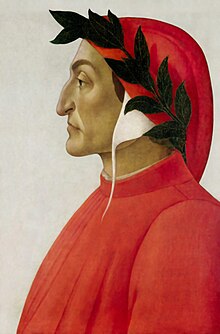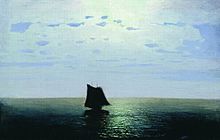Spotkanie w nocy
Spotkanie w nocy (ang. Meeting at Night) – wiersz Roberta Browninga opublikowany po raz pierwszy w 1845 roku w zbiorze zatytułowanym Dramatic Romances and Lyrics. Pierwotnie wiersz ten stanowił część dylogii Night and Morning, dopiero w późniejszych wydaniach poeta zatytułował obie części Meeting at Night i Parting at Morning[1].
Treść
Wiersz opisuje drogę, jaką jedno z kochanków przebywa, by spotkać się z drugim. Ponieważ podmiot mówiący utożsamia się z poetą, uważa się, że osobą podróżującą jest mężczyzna, choć w tekście angielskim nie ma wykładników rodzajowych[2].
- The grey sea and the long black land;
- And the yellow half-moon large and low;
- And the startled little waves that leap
- In fiery ringlets from their sleep,
- As I gain the cove with pushing prow,
- And quench its speed i' the slushy sand.
- Then a mile of warm sea-scented beach;
- Three fields to cross till a farm appears;
- A tap at the pane, the quick sharp scratch
- And blue spurt of a lighted match,
- And a voice less loud, thro' its joys and fears,
- Than the two hearts beating each to each!
- And the yellow half-moon large and low;
Wersyfikacja
Utwór składa się z dwóch strof sześciowersowych o rzadko spotykanym, lustrzanym układzie rymów abccba deffed[3]. Taka sekwencja współbrzmień została najprawdopodobniej przejęta z literatury włoskiej, gdzie sonety rymują się niekiedy abbaabba cdeedc[4]. Taki układ wykorzystywał czasem Dante Alighieri. W Polsce stosował go w Setniku rymów duchownych obficie czerpiący z poezji włoskiej Sebastian Grabowiecki[5]. Wiersz jest toniczny, czteroakcentowy. W pierwszej strofie można zaobserwować wyrazistą instrumentację głoskową, polegającą na nasyceniu tekstu spółgłoską [l], nadająca mu walor eufoniczny. Występują też aliteracje na [p] i [s].
Obrazowanie
Nowatorstwo wiersza Meeting at Night polega na śmiałym, skrótowym operowaniu obrazem, co podkreśla Stanisław Barańczak[6]. Browning używa głównie rzeczowników. Zwraca przy tym uwagę na szczegóły, jak zapalenie zapałki i towarzyszący mu charakterystyczny dźwięk. Tego typu obrazowanie o wiele później legło u podstaw imagizmu[7]. Zastosowana przez Browninga metoda polega na sugerowaniu czytelnikowi uczuć i doznań bohaterów bez mówienia o nich wprost. W tym wierszu, ewidentnie należącym do nurtu poezji miłosnej, poeta w ogóle nie używa słowa love (miłość)[8]. Istnieje wiele interpretacji tego wiersza[9]. Niektóre z nich są dostępne w Internecie[10].
Przekłady
Wiersz Browninga należy do najczęściej tłumaczonych utworów poety. W Polsce przekładali go Jan Kasprowicz[11], Jerzy Pietrkiewicz[12], Juliusz Żuławski[13], Stanisław Barańczak[14] i Wiktor Jarosław Darasz[15]. Nasi tłumacze posługiwali się różnymi rodzajami wiersza, ale zgodnie zachowywali charakterystyczny schemat rymów.
Przypisy
- ↑ Zobacz The poems of Robert Browning. With an Introduction and Bibliography by Dr Tim Cook, Wordsworth Editions, Ware, 1994, s. 1018.
- ↑ W pierwszej zwrotce pojawia się zaimek I (ja), który nic nie mówi o płci, a w drugiej zwrotce brak zaimków odnoszących się do osób.
- ↑ Joseph Berg Esenwein, Mary Eleanor Roberts, The art of versification, Springfield, 1920, s. 120.
- ↑ Dante użył schematu cdeedc w sonecie Piangete, amanti, poi che piange Amore z cyklu Vita nuova: Audite quanto Amor le fece orranza,/ch’io ’l vidi lamentare in forma vera/sovra la morta imagine avvenente;/e riguardava ver lo ciel sovente,/ove l’alma gentil già locata era,/che donna fu di sì gaia sembianza.
- ↑ Mirosława Hanusiewicz: Świat podzielony. O poezji Sebastiana Grabowieckiego. Lublin: Fundacja Jana Pawła II – Redakcja wydawnictw Katolickiego Uniwersytetu Lubelskiego, s. 133. ISBN 83-228-0350-8.
- ↑ Od Chaucera do Larkina. 400 nieśmiertelnych wierszy 125 poetów anglojęzycznych z 8 stuleci, Kraków 1993, s. 328.
- ↑ imagizm, [w:] Encyklopedia PWN [online] [dostęp 2016-10-06].
- ↑ Victorian Era: October 2014, victorian-poetry.bloomyebooks.com [dostęp 2020-07-09].
- ↑ Acep Heri Rizal: A Figurative Language and Imagery Analysis on Robert Browning Poems (ang.). repository.uinjkt.ac.id. [dostęp 2016-10-06].
- ↑ Lihua Zhang: Double Vision in Browning’s Meeting at Night and Parting at Morning (ang.). academypublication.com. [dostęp 2016-10-06].
- ↑ Poeci angielscy. Wybór poezyi, Lwów 1907.
- ↑ Jerzy Pietrkiewicz, Antologia liryki angielskiej 1300-1950, Warszawa 1987, 1997.
- ↑ Robert Browning, Poezje wybrane, tłum. Juliusz Żuławski, Warszawa 1969.
- ↑ Miłość jest wszystkim, co istnieje. 300 najsławniejszych angielskich i amerykańskich wierszy miłosnych. Poznań 1992; Od Chaucera do Larkina. 400 nieśmiertelnych wierszy 125 poetów anglojęzycznych z 8 stuleci, Kraków 1993
- ↑ Fraza, 3/2001.
Media użyte na tej stronie
Autor: Thornbury, Walter, 1828-1876, Licencja: No restrictions
Identifier: twocenturiesofso00thor (find matches)
Title: Two centuries of song : or, Lyrics, madrigals, sonnets, and other occasional verses of the English poets of the last two hundred years
Year: 1867 (1860s)
Authors: Thornbury, Walter, 1828-1876
Subjects: English poetry
Publisher: London : Sampson, Low, Son and Marston
Contributing Library: University of California Libraries
Digitizing Sponsor: MSN
View Book Page: Book Viewer
About This Book: Catalog Entry
View All Images: All Images From Book
Click here to view book online to see this illustration in context in a browseable online version of this book.
Text Appearing Before Image:
HOME THOUGHTS, FROM THE SEA. Nobly, nobly Cape Saint Vincent to the north-west died away ;Sunset ran, one glorious blood-red, reeking into Cadiz Bay ;Bluish mid the burning water, full in face Trafalgar lay ;In the dimmest north-east distance, dawned Gibraltar grand and gray ;Here and here did England help me, — how can I help England ?—say,Whoso turns as I, this evening, turn to God to praise and pray,While Joves planet rises yonder, silent over Africa. MEETING AT NIGHT. The grey sea and the long black land ;And the yellow half-moon large and low ;And the startled little waves that leapIn fiery ringlets from their sleep.As I gain the cove with pushing prow,And quench its speed in the slushy sand.Then a mile of warm sea-scented beach ;Three fields to cross till a farm appears ;A tap at the pane, the quick sharp scratchAnd blue spurt of a lighted match.And a voice less loud, thro its joys and fears,Than the two hearts beating each to each !
Text Appearing After Image:
rS P SONG FROM PIPPA PASSES. PiPPA. The years at the spring,And days at the morn ;Morning s at seven ;The hill-sides dew-pearled :The larks on the wing- :The snails on the thorn ;Gods in his heaven—Alls right with the world !284
Note About Images
Moon night in the sea (painting by Arkhip Kuindzhi)





